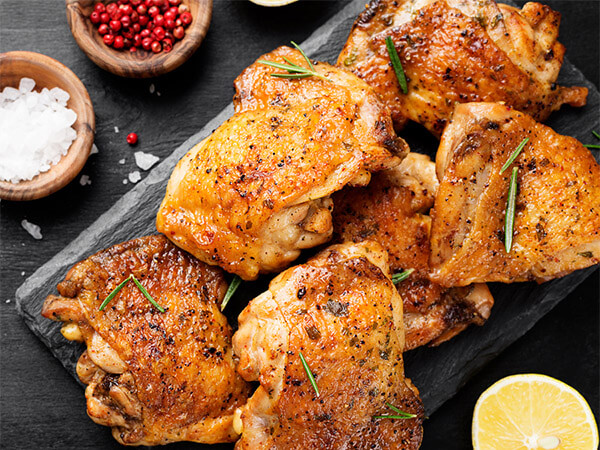Crispy Chicken Skin on
The Propane Kamado Grill
How
to get crispy chicken skin on the propane kamado grill?
Today we are going to learn how to get crispy chicken skin by combining and
“stacking” some of the following methods that
guarantee crispiness almost every time.
Start with a Dry Bird
You don’t have to be a rocket scientist to understand that wet stuff never gets brittle. Therefore, the first step in achieving crispy chicken skin is to remove unnecessary moisture.
If your chicken is frozen, you will need to thaw it thoroughly first. Check out our guide on how to thaw chicken quickly for tips.
If not frozen, first unwrap your chicken, either whole or in pieces, and pat it dry on all sides with a paper towel. Don’t rub too hard; just press the towel against your skin and let it absorb the water.
Next, let the chicken
air dry in the refrigerator. Leave it open on a plate for at least a few hours,
but preferably overnight. It is very safe and traces of moisture remaining on
the surface will evaporate.
Smooth Stretch
It’s time to channel your inner plastic surgeon and give your chicken a facelift and a tummy tuck! Raw, skin-on chicken can be an ugly, wrinkled thing, all of which can absorb moisture and cause uneven cooking.
Since
the skin is loose, it can be pulled out and stretched and smoothed until tight.
You can use scissors to remove excess flaps and a toothpick or fork to secure
the edges. The puffed skin will cook evenly without moisture.
Salt Your Way to success
If you’ve read salting, you know that salt is effective at absorbing moisture from the meat. Even if you don’t, you may have noticed that bathing in salt water can dry out your skin. The same goes for chicken.
As an add-on to drying chicken in the refrigerator, try sprinkling salt on the skin to help absorb moisture from the inside. However, don’t use table salt; you’ll need to use kosher or flaky sea salt for this.
Some
people recommend rubbing the salt a little so that it penetrates the surface.
Be gentle though, or you’ll just tear the skin to shreds. When you’re ready to
add your favorite chicken rub for smoking, pat the chicken again with a paper
towel and place it on the grill.
Searing and Separation
This is an interesting technique worth trying. We tend to keep chicken away from direct heat because we are so afraid of burning or drying out the meat. However, a carefully monitored searing may be just what you need to get your skin brittle.
Overheat the grill before placing the chicken on the grill. However, don’t place it directly over the flame; either turn off a burner and leave it there, or push some charcoal aside and throw it away. This reduces incidents caused by dripping juice.
Grill each side for 3-4 minutes, then move it to a true indirect heat zone to continue cooking. After a few minutes, carefully remove the skin with tongs and place it directly on the grate, either in the same “cool” area, or further away from the flame.
When
the chicken is ready, remove it from the grill, but keep cooking the skin. Once
it’s golden and crispy, remove it from the grill and cover your chicken.
Turn Up the Heat…for a while
Similar to searing, you can try putting the chicken on the grill at a much higher temperature than usual. Consider 400F or higher, but still away from direct heat to reduce flare-ups. The heat will dry out the skin, but the skin will protect the meat.
Once
you see the skin start to brown, you may want to move the chicken to a cooler
area to finish cooking and prevent the inside from drying out. Remember: cook
to temperature, not look or time! Safe to eat when your instant read
thermometer reads 165F.
Open Tent Flaps While Resting
Allow the meat to rest after leaving the grill to allow time to finish the carryover cooking and tighten the protein chains. The tight protein retains moisture, so it doesn’t lose its delicious juices when you slice the meat.
Wrapping
the chicken in foil keeps the moisture inside, but it also makes the skin
soggy. Be sure to let some heat and steam escape from the end to prevent this
from happening.
Put Your Chicken Alone on the Grill
We make a fuss because we care! Many grills have a bad habit of constantly poking, poking, flipping, and moving the meat around the grill.
It’s always a good idea to set the meat aside and let it do its own thing. This is especially true of skin-on chicken. The more you move, the more likely it is to wrinkle or tear and interfere with the embrittlement process.
Use
your eyes, your gut, and your thermometer to know when is the right time to
handle your chickens. And check out our guide for more details on how long to
roast chicken.
Boiling Water Trick
This might sound a little crazy, and it’s definitely counterintuitive. The secret to crispy chicken skin may be more water, not less!
Follow the freezer drying technique above and add salt to the chicken to remove more moisture. When you’re ready to take the chicken out of the refrigerator to cook, fill the kettle with water and let it boil.
Put
the chicken in the sink and pour boiling water over every inch of the chicken,
being careful not to burn yourself. You should notice that the skin actually
shrinks and fits snugly against the outline of the chicken frame. When done,
pat the chicken dry again and it’s ready to bake.
Separation and Stamping
Under the skin of the chicken, there is a layer of fat. Fat adds moisture when rendered, so we like to use it for juicy steaks. We don’t like soggy chicken skin.
Carefully run a knife between the skin and the flesh to separate the two, but don’t tear the skin or actually remove it. Then, poke some holes here and there with a fork.
As
the chicken cooks, the fat will present as usual. However, between the hole and
the separation, most of the fluid will leak out. This should help the skin
crisp up nicely. This is not an easy technique, so be sure to determine your
knife skills before starting.
Miss the Marinade
Yes,
a good dunk in the marinade can add a lot of flavor to any meat. But, with
chicken, it’s the secret to soggy skin. Save it for skinless cuts.
Belay the Baste
Applying
the ointment too early will add moisture to the skin before it has a chance to
become brittle. Add it minutes before you’re ready to take it off the grill.
Save the Sauce
Like sauce, savory barbecue sauce adds moisture that you don’t want. It’s like applying lotion on dry skin.
Instead, either use it as a dip or use it as you remove the chicken from the grill so it has a minute or so to sear.
Skip the Smoker
Smoked chicken is great. But it’s never crispy. Smokers are great for making edible tough meats by slowly rendering fat at low temperatures and adding moisture from a water tray.
For
a crispy crust, you want high heat and the shortest possible cooking time. You
can still add some smoked wood to season the chicken, just do it on a higher
heat in a gas or charcoal grill.

